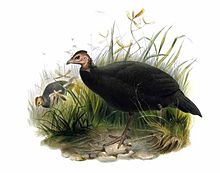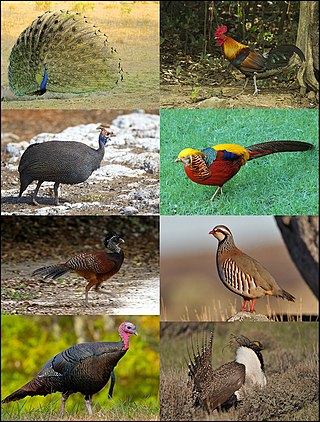
Galliformes is an order of heavy-bodied ground-feeding birds that includes turkeys, chickens, quail, and other landfowl. Gallinaceous birds, as they are called, are important in their ecosystems as seed dispersers and predators, and are often reared by humans for their meat and eggs, or hunted as game birds.

Guineafowl are birds of the family Numididae in the order Galliformes. They are endemic to Africa and rank among the oldest of the gallinaceous birds. Phylogenetically, they branched off from the core Galliformes after the Cracidae and before the Odontophoridae. An Eocene fossil lineage Telecrex has been associated with guineafowl; Telecrex inhabited Mongolia, and may have given rise to the oldest of the true phasianids, such as blood pheasants and eared pheasants, which evolved into high-altitude, montane-adapted species with the rise of the Tibetan Plateau. While modern guineafowl species are endemic to Africa, the helmeted guineafowl has been introduced as a domesticated bird widely elsewhere.
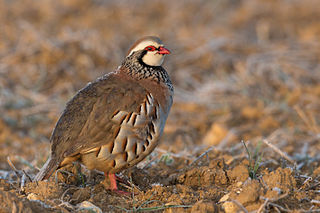
The red-legged partridge is a gamebird in the pheasant family Phasianidae of the order Galliformes, gallinaceous birds. It is sometimes known as French partridge, to distinguish it from the English or grey partridge. The genus name is from Ancient Greek alektoris a farmyard chicken, and rufa is Latin for red or rufous.
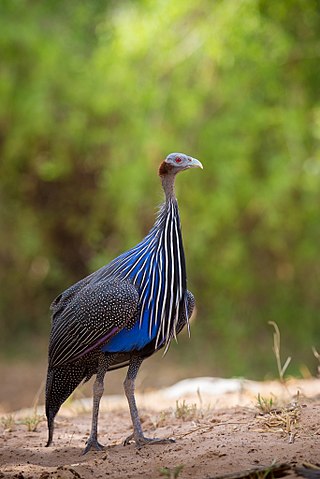
The vulturine guineafowl is the largest extant species of guineafowl. Systematically, it is only distantly related to other guineafowl genera. Its closest living relative, the white breasted guineafowl, Agelastes meleagrides inhabit primary forests in Central Africa. It is a member of the bird family Numididae, and is the only member of the genus Acryllium. It is a resident breeder in northeast Africa, from southern Ethiopia through Kenya and just into northern Tanzania.

The pin-tailed sandgrouse is a medium large bird in the sandgrouse family. It has a small, pigeon-like head and neck and a sturdy, compact body. It has long pointed wings, which are white underneath, a long tail and a fast direct flight. Flocks fly to watering holes at dawn. The call is a loud kattar-kattar. This gregarious species breeds on dry open treeless plains and similar habitats. Its nest is a ground scrape into which two or three cream-coloured eggs with cryptic markings are laid. Both sexes incubate the eggs.

The snowcocks or snowfowl are a group of bird species in the genus Tetraogallus of the pheasant family, Phasianidae. They are ground-nesting birds that breed in the mountain ranges of southern Eurasia from the Caucasus to the Himalayas and western China. Some of the species have been introduced into the United States. Snowcocks feed mainly on plant material.
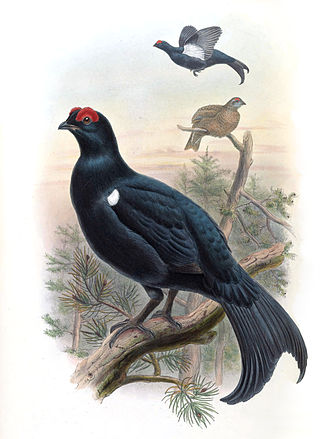
The Caucasian grouse or Caucasian black grouse is a large bird in the grouse family. It is closely related to the black grouse.

Salvadori's pheasant is a landfowl bird of genus Lophura, native to Indonesia. It is found in the mountain rainforests of Sumatra. Thus it is also known as the Sumatran pheasant. The Hoogerwerf's pheasant is usually thought to be a subspecies. This bird was first described in 1879 by the Italian ornithologist Tommaso Salvadori. The species name inornata means "without ornament".

The great argus, or greater argus, is a large species of pheasant from Southeast Asia. It is known for its impressive plumage and courtship behavior. It is not to be confused with the two species of closely related crested argus, genus Rheinardia.

Crested arguses are large and spectacular peafowl-like birds in the genus Rheinardia of the pheasant family.
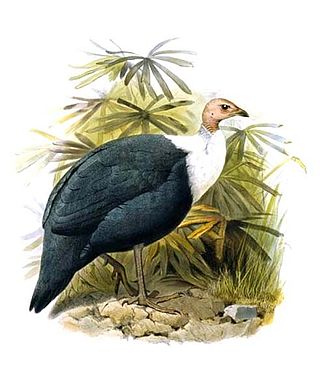
The white-breasted guineafowl is a medium-sized, up to 45 cm long, terrestrial bird of the guineafowl family.

The bar-backed partridge, also known as the brown-breasted hill-partridge, is a species of partridge in the family Phasianidae. It is found in southwestern China and Southeast Asia.
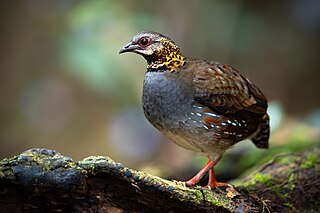
The rufous-throated partridge is a species of bird in the family Phasianidae. It is found in montane forests in India and Southeast Asia. The International Union for Conservation of Nature (IUCN) has assessed it as a least-concern species.

The starred wood quail is a species of bird in the family Odontophoridae. It is found in subtropical or tropical moist lowland forests of Bolivia, Brazil, Ecuador, and Peru.

The Altai snowcock is a species of bird in the family Phasianidae. It is found in western Mongolia and adjacent areas of China, Kazakhstan and Russia. Its natural habitat is boreal forests.

The spotted sandgrouse is a species of ground dwelling bird in the family Pteroclidae. It is found in arid regions of northern and eastern Africa and across the Middle East and parts of Asia as far east as northwest India. It is a gregarious, diurnal bird and small flocks forage for seed and other vegetable matter on the ground, flying once a day to a waterhole for water. In the breeding season pairs nest apart from one another, the eggs being laid in a depression on the stony ground. The chicks leave the nest soon after hatching and eat dry seed, the water they need being provided by the male which saturates its belly feathers with water at the waterhole. The spotted sandgrouse is listed as being of "least concern" by the International Union for Conservation of Nature in its Red List of Threatened Species.

The Vietnamese crested argus is a large and spectacular peafowl-like species of bird in the pheasant family with dark-brown-spotted black and buff plumage, a heavy pink bill, brown irises and blue skin around the eyes. The head has two crests; the hind crest, which extends down the occiput, is erected when alarmed and during intentional behaviors including pair bonding and courtship displays. The male has a broad and greatly elongated tail of twelve feathers. The tail covert of the male is the longest of any bird and is believed to contain the longest feathers to occur in a wild bird; the Reeves's pheasant has tail feathers of similar length but which are considerably narrower. The tail coverts measure up to 1.73 m (5.7 ft) in length, giving the bird a total length of 1.9–2.39 m (6.2–7.8 ft).

The Malayan crested argus is a large and spectacular peafowl-like species of bird in the pheasant family with dark-brown-spotted black and buff plumage, a heavy pink bill, brown irises and blue skin around the eyes. The head has two crests; the hind crest, which extends down the occiput, is erected when alarmed and during intentional behaviors including pair bonding and courtship displays. The male has a broad and greatly elongated tail of twelve feathers. The tail covert of the male is the longest of any bird and is believed to contain the longest feathers to occur in a wild bird; the Reeves's pheasant has tail feathers of similar length but which are considerably narrower. The tail coverts measure up to 1.73 m (5.7 ft) in length, giving the bird a total length of 1.9–2.39 m (6.2–7.8 ft).
